

“Design Thinking” For Healthcare. Oftentimes the healthcare design industry at large is asked to think a whole lot about the “B” side of an “A-to-B” scenario.
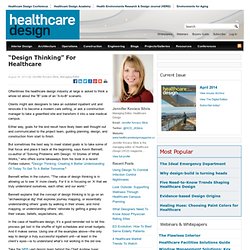
Clients might ask designers to take an outdated inpatient unit and renovate it to become a modern care setting, or ask a construction manager to take a greenfield site and transform it into a new medical campus. Either way, goals for the end result have likely been well thought out and communicated to the project team, guiding planning, design, and construction from start to finish. But sometimes the best way to meet stated goals is to take some of that focus and place it back at the beginning, says Kevin Bennett, co-author of “Solving Problems with Design: 10 Stories of What Works," who offers some takeaways from his book in a recent Forbes column, "Design Thinking: Creating A Better Understanding Of Today To Get To A Better Tomorrow.
" Bennett writes in the column, "The value of design thinking is in allowing us to see ‘A’ more clearly. Design Thinking in Health Care. The Healthcare Innovator’s Challenge. Adapted from Design for Care (page 253 ) The innovator’s challenge in healthcare is not a technological fix – it is more to understand and preserve core values of human care while changing practices for durable social and economic benefit.

Www.kpmg.com/IN/en/IssuesAndInsights/ThoughtLeadership/Excellence_in_Diagnostic_Care.pdf. TV : Keynote 1: Maureen Bisognano. Innovation In Care Transitions: Who’s Buying? A few weeks ago Lisa Suennen, founding partner of Psilos Group and fledging best-seller author, wrote ”Times of massive system transformation, such as we are in today, pave the way for new market entrants and disruptive technologies a la Clayton Christensen’s stories about other industries that have endured dramatic change. ” She was talking about health insurance exchanges, but could just as well have been talking about care transitions.
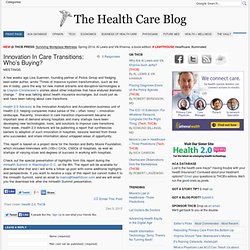
Health 2.0 Advisors is the Innovation Analytics and Acceleration business unit of Health 2.0, helping companies make sense of the – often ‘noisy’ – innovation landscape. Recently, innovation in care transition improvement became an important area of demand among hospitals and many startups have been developing new technologies, tools, and solutions to improve care transitions. Check out the special presentation of highlights from this report during the mHealth Summit in Washington D.C. on the 8th. HealthLoop: A Health 2.0 Story. Why are bundled payments so attractive for hospitals and physician groups? Hosts: From the Healthcare & Life Sciences Institute Date/Time: Oct. 04, 2013 | 2:00pm ET Event Overview Represented as one of the primary strategies being used to transition away from fee-for-service, bundled payments are gaining increased attention from many hospitals and physician groups.
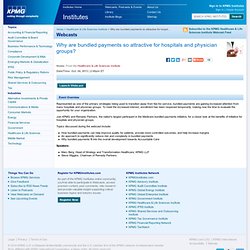
To meet the increased interest, enrollment has been reopened temporarily, making now the time to evaluate the opportunity for your organization. Join KPMG and Remedy Partners, the nation's largest participant in the Medicare bundled payments initiative, for a closer look at the benefits of initiative for hospitals and physician groups. Topics discussed during the webcast include: High-Value Health Care — A Sustainable Proposition. Health care in the United States is at a crossroads.
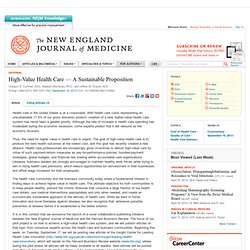
With health care costs representing an unsustainable 17.6% of our gross domestic product, creation of a new, higher-value health care system has never been a greater priority. Although the rate of increase in health care spending has moderated during the economic recession, some experts predict that it will rebound as the economy recovers. Thus, the need for higher value in health care is urgent. The goal of high-value health care is to produce the best health outcomes at the lowest cost, and this goal has recently created a new alliance. From volume to value; uitkomstbekostiging in de praktijk. Geplaatst op 16 september 2013 door: David Ikkersheim | 4 reacties | Reageer De uitdaging waar bijna alle Westerse landen voor staan is het verminderen van de kostengroei in de zorg, met bij voorkeur het verbeteren van de kwaliteit.

Een aantal jaar terug zou het merendeel van de mensen gezegd hebben dat dit helemaal niet kon. Decline In Utilization Rates Signals A Change In The Inpatient Business Model. Use rates for inpatient and certain hospital outpatient services are declining in many areas of the country, reflecting fundamental change brought by the new business model. Importantly, as evidenced by trends in Chicago and Minnesota, there also appears to be a correlation between the level and pace of a market’s shift toward value-based care and the level and pace of utilization decline. We believe this trend is here to stay and that it has significant strategic and financial implications for health care providers. Specifically, providers that embrace the migration to value-based care will need to work aggressively to eliminate unnecessary and/or ineffective activities in order to thrive under risk contracts.
Study: Market power drives up hospital prices. Hospital costs for those who are privately insured vary widely and are much higher than Medicare payment rates, a new study by the Center for Studying Health System Change (HSC) found.
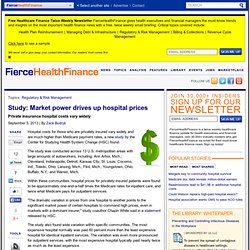
The study was conducted across 13 U.S. metropolitan areas with large amounts of autoworkers, including: Ann Arbor, Mich.; Cleveland; Indianapolis; Detroit; Kansas City; St. Louis; Cocomo, Ind., Toledo, Ohio; Lansing, Mich.; Flint, Mich.; Youngstown, Ohio; Buffalo, N.Y.; and Warren, Mich.